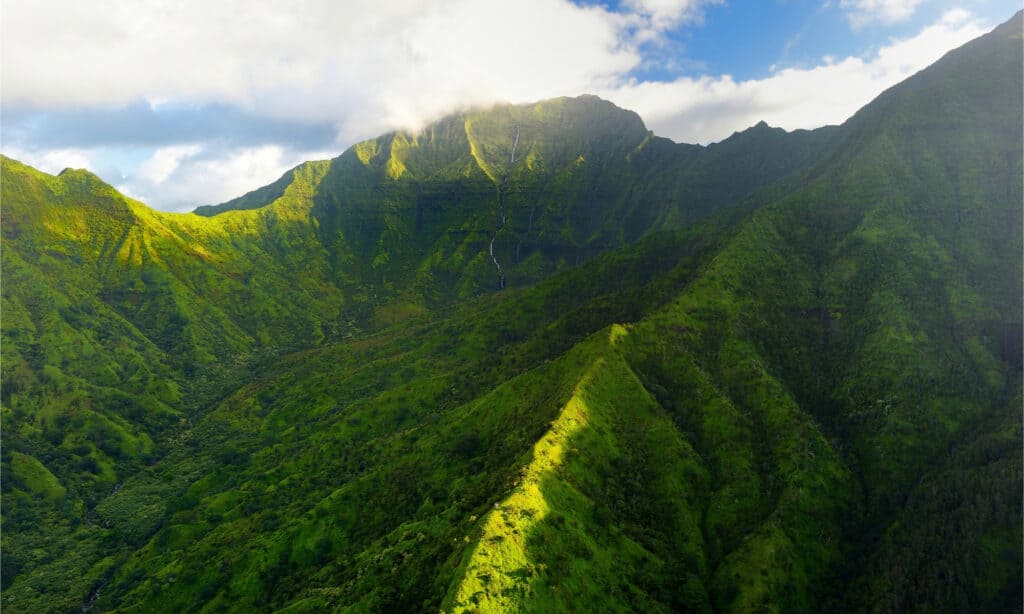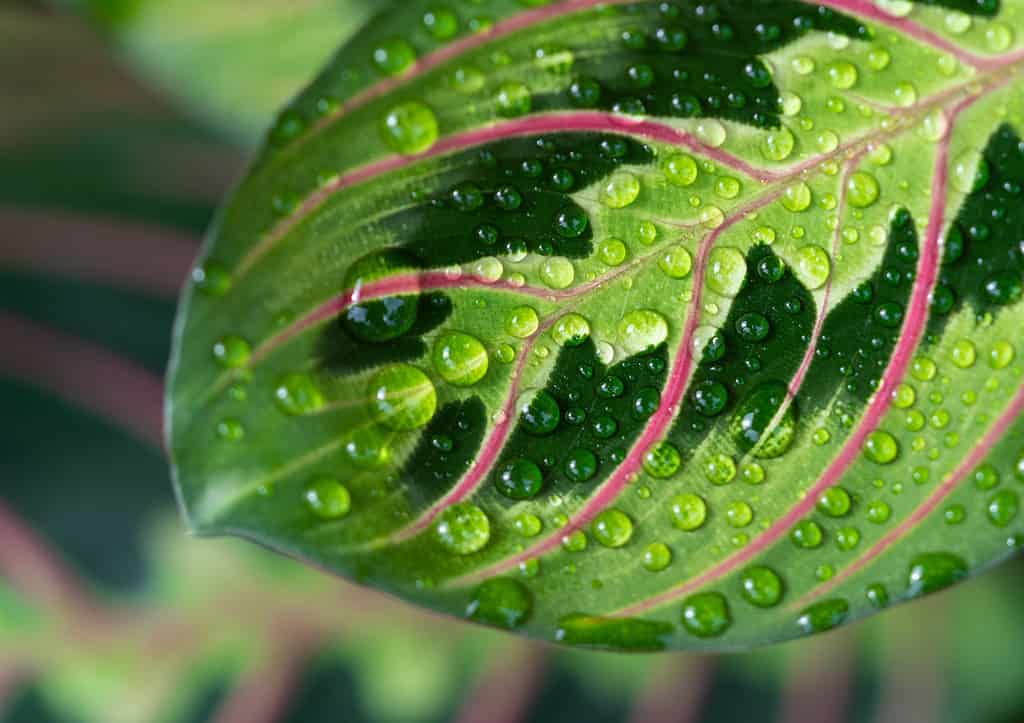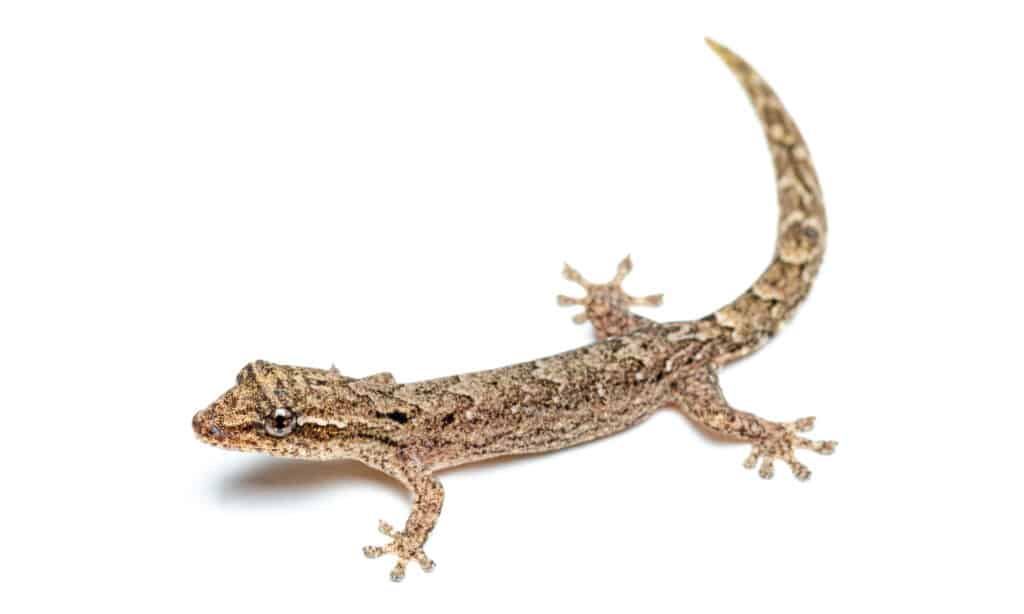At a time when vast swaths of the United States are experiencing drought conditions and the Mississippi River is at a historic low, it is comforting to know that there are still parts of the country that get a lot of water. At one point, a location in the U.S. reached 12 feet of rain—in a single month!
The U.S. Location That Got 12-Feet of Rain in a Single Month

Mount Wai’ale’ale is one of the wettest places in the U.S. This location once got 12 feet of rain in a month!
©EdoTealdi/iStock via Getty Images
Mount Wai’ale’ale is considered one of the two wettest locations in the U.S.—the other is Big Bog, on Maui. In March 1982, Mount Wai’ale’ale saw 149 inches (3,800 millimeters) of rain. That’s over 12.4 feet! Compare that to California’s most significant monthly rainfall total, which was 82 inches (about 2.1 meters) of rain in Camp 6, 1981.
Location of Mount Wai’ale’ale
Mount Wai’ale’ale is located in the center of the island of Kaua’i, the northernmost island of Hawaii. It is the second-highest point on the island, next to Kawaikini Peak. It is at about the same latitude as Cuba, making it susceptible to the equatorial trade winds or easterlies, which play a role in its rainy climate.
Geography of Mount Wai’ale’ale

Mount Wai’ale’ale’s unique shape funnels rain to a single spot on the island.
©MNStudio/Shutterstock.com
Mount Wai’ale’ale is the inactive shield volcano that forms the Hawaiian island of Kaua’i. Kaua’i is the oldest of Hawaii’s main islands and part of the Emperor Seamount Chain. Ancient lava flows have created fertile soil for the green vegetation which adorns its slopes. The near-constant rain has helped create lush rainforests and bogs which fill the island’s interior. However, the top of the mountain is nearly bare due to vegetation not being able to grow in the deluge. The cloud cover at the top of the mountain also allows very little sunlight through.
Weather Patterns of Mount Wai’ale’ale
There are two seasons—winter (rainy) and summer (dry). The trade winds drive weatWai’ale’alest to west, funneling cloud cover and rain through the cliffs on three sides of the mountain. This is what causes Mount Wai’ale’ale to have an average of 289 days of rain per year. The whole island sits in a tropical rainforest climate.
Rain Records in Mount Wai’ale’ale

Mount Wai’ale’ale holds the record for a single month of rainfall in the U.S.
©MargaretW/iStock via Getty Images
1982 was a very rainy year for Mount Wai’ale’ale. In addition to the U.S. location’s single-month record for rain, Mount Wai’ale’ale set a yearly record. That year, 683 inches (17,300 mm) of rain fell there.
Why Does It Rain So Much in Mount Wai’Ale’Ale
The location of Mount Wai’ale’ale, in addition to its height and unique shape, works together to create a natural funnel for rain clouds. Its northern location exposes it to more rain-bearing clouds in the winter. Its conical shape means that all sides of the mountaintop are exposed to rain clouds. The three cliffs to the north, east, and south of the mountain’s peak channel warm, moist air to the top, where it can meet with clouds carried by the trade winds. This moisture is then wrung out between Mount Wai’ale’ale and the trade inversion layer, the ceiling for trade wind clouds. The top of the mountain sits just below the layer.
Wildlife of Mount Wai’ale’ale

The Hawaiian goose is the rarest in the world. It can be found on the slopes of Mount Wai’ale’ale.
©Wunson/Shutterstock.com
The mountaintop itself is not hospitable to wildlife, but the wilderness preserve on the western slope, Alakaʻi Wilderness Preserve, consists of a bog that provides a habitat for diverse wildlife.
Hawaiian Goose
The Hawaiian goose or nene is the state bird of Hawaii. It is the most endangered goose in the world. This is due to overhunting and the introduction of exotic animals that preyed upon them, reducing their numbers. The young can eat independently after hatching, but they stay with their parents for about a year, which is good because Hawaiian geese don’t assert dominance by aggression but by the size of their families. Their numbers are starting to make a recovery after some protective practices were put into place.
Mourning Gecko

The mourning gecko hides in the foliage of Mount Wai’ale’ale, waiting until nightfall to come out and hunt.
©Peter Yeeles/Shutterstock.com
Among Hawaii’s smallest reptiles, mourning geckos are fast and reclusive. They like to hide in foliage during the day and then come out to hunt insects at night. The most fascinating thing about these small, gray, and brown geckos is that they are almost all females. They are capable of asexual reproduction, otherwise known as parthenogenesis. Females lay one or two eggs, and the resulting young are essentially genetic copies. Males are rare and typically infertile.
Hawaiian Garden Spider

The Hawaiian garden spider spins marvelous zigzag webs through the forests of Mount Wai’ale’ale.
©Arik.wib/Shutterstock.com
The Hawaiian garden spider is one of the largest spiders in Hawaii, measuring about 2.5 inches in size. They are very colorful, with yellow abdomens and other colors, including black, white, orange, and gray. These garden spiders make large webs with zigzag patterns (stabilimenta). They also have a painful bite that can cause redness and swelling but is otherwise not dangerous.
How Wildlife Survives in the Rain
In a place that holds the U.S. location record for rain in a month, wildlife has been unable to establish itself here but can be found in the Alakaʻi Wilderness Preserve to the west. Animals here have developed adaptations, allowing them to survive the frequent downpours on the island. Some have specialized diets, such as foraging for insects in the moist ground below or feeding on nectar. Others have developed oily feathers or scales that shed water to help them handle the constant moisture. Breeding and nesting habits are also different to prevent flooding from impacting them.
The photo featured at the top of this post is © Brian A Jackson/Shutterstock.com
Thank you for reading! Have some feedback for us? Contact the AZ Animals editorial team.






